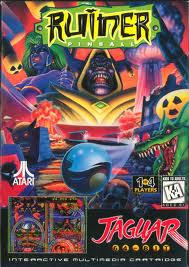
The Atari Jaguar is a home video game console developed by Atari Corporation and released in North America in November 1993. Part of the fifth generation of video game consoles, it competed with the 16-bit Sega Genesis, the Super NES and the 32-bit 3DO Interactive Multiplayer that launched the same year. Powered by two custom 32-bit processors – Tom and Jerry – in addition to a Motorola 68000, Atari marketed it as the world's first 64-bit game system, emphasizing its 64-bit bus used by the blitter. The Jaguar launched with Cybermorph as the pack-in game, which received divisive reviews. The system's library ultimately comprised only 50 licensed games.

Pinball Fantasies is a 1992 pinball video game originally developed by Digital Illusions and published by 21st Century Entertainment in Europe for the Amiga home computers. It is the sequel to Pinball Dreams, which was released earlier in the same year on multiple platforms. In the game, players can choose between any of the four available playfields, both of which have their own thematic and main objectives in order to obtain the highest score possible.
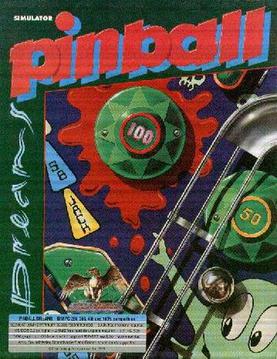
Pinball Dreams is a pinball simulation video game developed by Digital Illusions and originally released for the Amiga in 1992. It spawned several sequels, including Pinball Fantasies and Pinball Illusions. The MS-DOS port was digitally released by Rebellion Developments along with its sequel and Pinball Mania on February 22, 2011 on GOG.com with support for Microsoft Windows. It received an OS X build on April 23, 2013; and a Linux build on August 19, 2014.

Alien vs Predator is a 1994 first-person shooter developed by Rebellion Developments and published by Atari Corporation for the Atari Jaguar. It was also distributed in Japan by Mumin Corporation, where it became a pack-in game for the console. It is the first entry in the Alien vs. Predator franchise developed by Rebellion. Taking place in a simulation depicting the fall of the Golgotha training base camp, the game offers three playable scenarios: Alien, Predator, or a human of the Colonial Marines. The player is presented with a series of interconnected sublevels and ships to progress through. Each character has different objectives, abilities, weapons, and disadvantages.

Fight for Life is a 1996 fighting video game developed and published by Atari Corporation in North America and Europe for the Atari Jaguar. It was the final game to be developed and published by Atari themselves before dropping support for the platform and merging with JT Storage in a reverse takeover on July 30, 1996, and the last fighting title released for the console. Set in a purgatory dimension known as the Specter Zone, Fight for Life follows eight deceased fighters as they enter a tournament held by a shapeshifting being called the Gatekeeper, who will bestow a second chance at life to the winner. Its gameplay consists of one-on-one fights, with a main eight-button configuration, featuring special moves and the ability to customize character's movesets, as well as four different playable modes.
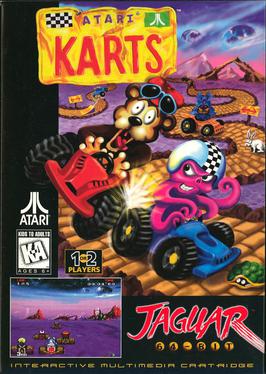
Atari Karts is a kart racing video game developed by Miracle Designs and published by Atari Corporation for the Atari Jaguar in North America on December 22, 1995, and Europe on January 1996. In the game, the players take control of one of several playable characters, each with differing capabilities. One or two players race against computer-controlled characters in four cups consisting of multiple tracks over four difficulty levels. During races, the players can obtain power-ups placed at predetermined points in the tracks and use them to gain an advantage. It plays similarly to Super Mario Kart and features Bentley Bear, main protagonist of the arcade game Crystal Castles (1983).

White Men Can't Jump is a 1995 basketball video game developed by High Voltage Software (HVS) and published by Atari for the Atari Jaguar. It is loosely based on the 1992 20th Century Fox film of the same name. The game features a loose version of basketball known as streetball. It can be played against computer-controlled opponents, or up to four human competitors using the Team Tap multitap.

Obsession is a pinball video game developed and originally published by Unique Development Sweden for the Atari STe on December 2, 1994. It is the first video game to be created by UDS and one of the last official releases for the Atari ST platform after being discontinued in 1993 by Atari Corporation. In the game, players can choose between any of the four available playfields, both of which have their own thematic and main objectives in order to obtain the highest score possible.
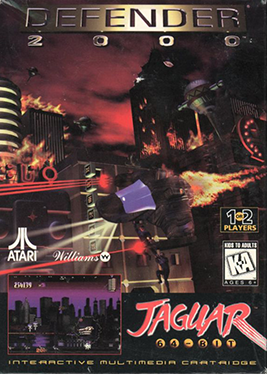
Defender 2000 is a 1996 scrolling shooter video game developed by Llamasoft and published by Atari Corporation for the Atari Jaguar. Part of Atari's 2000 series of arcade game revivals, it is an update of Eugene Jarvis' arcade game Defender (1981). The premise takes place in a future where the Alpha Promixian empire attack mining settlements on distant resource planets. Gameplay is divided into three modes, with the player acting as part of the System Defense Team commanding the Threshold ship to defeat waves of invading aliens while protecting humans.

Frank Thomas Big Hurt Baseball is a multiplatform baseball simulation game that was licensed by the Major League Baseball Players Association, featuring the likeness, motion captured movements, and "Big Hurt" branding of player Frank Thomas.

Battlemorph is a 1995 shooter video game developed by Attention to Detail (ATD) and published by Atari Corporation for the Atari Jaguar CD. It is the sequel to Cybermorph (1993), a pack-in game for the Atari Jaguar. Taking place 30 years after the events of the original game, the player pilots the morphing infiltration fighter War Griffon in an extermination mission against the Pernitia empire, which plans to launch a full-scale invasion to eradicate humanity and take over the galaxy after being pushed back to their home planet. The player is tasked with various objectives, while fighting against enemies and bosses, across eight galaxy clusters in order to liberate them from control of the empire.

Attack of the Mutant Penguins is a action-strategy video game developed by Sunrise Games and published by Atari Corporation for the Atari Jaguar in Europe on December 1995, and North America on March 15, 1996. A port titled Mutant Penguins was released in 1996 by GameTek for MS-DOS. The plot follows Bernard and Rodney, intergalactic heroes defending earth against alien invaders disguised as penguins. The player must dispatch the alien penguins before they reach a doomsday weapon, in the form of a weighing scale. Earth also has real penguins, who help the player by fighting the aliens and counteracting their weight on the scale.

Thea Realm Fighters (TRF) is an unreleased fighting game that was in development by High Voltage Software and planned to be published by Atari Corporation on a scheduled October 1995 release date exclusively for both the Atari Jaguar and the Atari Jaguar CD add-on.

Power Drive Rally is a 1995 racing video game developed by Rage Software and published by Time Warner Interactive for the Atari Jaguar. It is a conversion of the 1994 racing game Power Drive, which was released on multiple platforms. Revolving around rallying, the game features six real vehicles and circuits based on eight locations around the world. The players participate in various racing events and earn money by qualifying or winning to continue the rally season and repair damage to the car.
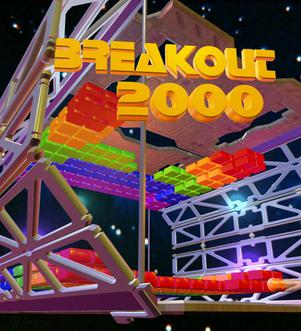
Breakout 2000 is a 1996 action video game developed by MP Games and published by Telegames for the Atari Jaguar. Part of the 2000 series by Atari Corporation, it is a remake of the arcade game Breakout (1976), and one of the last officially licensed releases for the platform. Featuring a similar premise to Breakout, the player must destroy a layer of brick lines by repeatedly bouncing a ball spawned off a paddle into them and keep it in play. Gameplay modifications to the original game include a third-person perspective behind the paddle in a pseudo-3D playfield, power-ups, bonus levels, enemies, varying level designs, and multiplayer features.

Checkered Flag is a 1994 racing video game developed by Rebellion Developments and published by Atari Corporation for the Atari Jaguar. It is a conversion of the 1991 Atari Lynx title of the same name. In the game, the player controls a Formula One car competing against computer-controlled opponents in races across multiple locations. Gameplay consists of three modes, and the player can choose various weather conditions or customize the vehicle's characteristics.
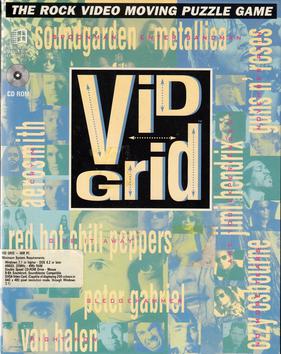
Vid Grid is a tile-matching full motion video puzzle game originally developed by Geffen Records and published by Jasmine Multimedia Publishing for Windows on September 13, 1994. It was later ported to the Atari Jaguar CD by High Voltage Software in 1995, where it was included along with Blue Lightning as one of the pack-in games for the peripheral when it launched. It is the first entry in the series of the same name.

Iron Soldier 2 is an open world first-person mecha simulation video game developed by Eclipse Software Design and published by Telegames for the Atari Jaguar and Atari Jaguar CD on December 30, 1997. It is the sequel to Iron Soldier.
Dactyl Joust is an unreleased action-platform video game that was in development by High Voltage Software and planned to be published by Atari Corporation on a scheduled November 1995 release date exclusively for both the Atari Jaguar and the Atari Jaguar CD add-on. It was intended to be a remake of John Newcomer's 1982 arcade game Joust, where players take control of a knight riding a pterodactyl, instead of a flying ostrich, on a first-person perspective battling and defeating groups of enemy knights riding dactyls. The game formed part of a partnership deal between Atari Corp. and Williams Entertainment that included plans to update and release some of the latter's early arcade games for the Jaguar platform.
